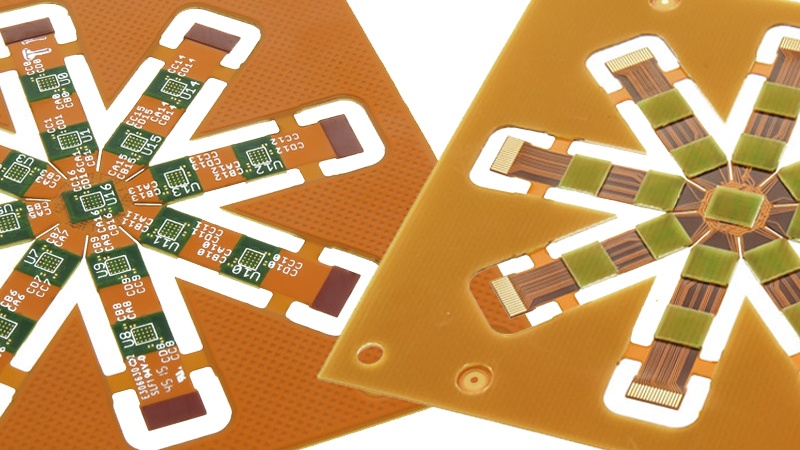In the world of flexible circuit boards, stiffeners are a common requirement in a lot of flex designs. By definition, a circuit board stiffener provides a mechanical support function and is not part of the electrical schematic of a design.
For the majority of applications, stiffener requirements fall in one or both of the following categories:
- Rigidize localized areas to support components and or connectors.
- Increase the flex circuit thickness in specific areas to either meet ZIF connector specifications or to constrain bend areas to predefined locations.

Example of Flex Circuit Stiffener
Rigidizing Stiffeners Help Support Components
In many instances a stiffener is used to create a localized rigid area in the flex circuit where components and or connectors are attached. This also prevents the circuit from being bent in or adjacent to the component area(s) which can potentially compromise the part’s solder joint integrity.
FR4 Stiffeners for Flexible PCBs
The most common material used for stiffeners in flex PCB designs is FR4 with thicknesses varying from 0.008” up to 0.059”. The most common thicknesses used are 0.020”, 0.031”, 0.039” or 0.059”. The general rule is to use the thickest stiffener that the design will allow for up to 0.059” which replicates a traditional rigid printed circuit board.
When utilizing a stiffener for plated-through hole (PTH) components, the stiffener(s) need to be located on the same side of the flex from which the component is inserted to allow access to solder pads on the flex circuit. FR4 stiffeners may also have copper features, e.g.; pads or plated holes used for component mounting purposes etc.
Additional Stiffener Materials
In some flexible circuit designs, alternate materials, such as stainless steel or aluminum are available. These are typically used for applications requiring heat sinking or added rigidity but will significantly increase the cost of the parts and should only be used when required.
Flex Stiffener Attachment Methods
The preferred attachment method is to thermally bond the stiffener to the circuit (using heat and pressure). This method utilizes the same flexible adhesive as used to attach the Coverlays. This manufacturing process will result in a very strong permanent bond.
An alternative attachment method available is done with a pressure sensitive adhesive (PSA), e.g.: 3M467 or 3M9077, if the design prevents the use of a flex adhesive. The specific PSA will depend on whether the flex PCB will be subjected to an automated reflow cycle and or what material it is to be adhered to.
Type of adhesive will also depend upon the configuration and or location of the stiffener(s). For an example, if a stiffener does not extend out to the circuit outline it will, in most cases, require a PSA attachment and an additional stiffener outline added to the silkscreen to allow for accurate placement.
Multiple Stiffener Thicknesses in the Same Design
In some cases, multiple stiffener thicknesses can be used within the same flex circuit design. A manufacturability review done by your supplier is required as there are some limitations in this process.
Stiffeners can be attached to either one or both sides of a part. If attached to both sides the assembly requirements and assembly array configuration will need to be reviewed by your supplier to determine if there will be any complications at assembly.
For flex circuit designs with an assembly array requirement, it is common and cost effective to include the FR4 stiffener throughout the array border. This results in a rigid array which in most cases, allows the parts to run through automated assembly in the same manner as a rigid circuit board design eliminating the need for any additional tooling plates etc.
Using Stiffeners to Increase Thickness
Polyimide stiffeners are the most common method to achieve the thickness requirement, at the contact fingers, as specified by the ZIF connector that the flex circuit plugs into. Some common thickness requirements are 0.3mm or 0.2mm. This thickness is be achieved by adding a thin Polyimide layer in the finger area only per the connector specifications. Stiffener thickness can vary between 0.002” and 0.008” depending upon the flex circuit material construction what the added amount is required to meet the connector spec.
It is not recommended to design a “thicker” flex PCB in an attempt to eliminate the need for a ZIF stiffener. This will result in an excessively thick part that will not have the required flexibility or bend reliability and will be much more costly. ZIF connectors have tight dimensional tolerance in the finger area width, so only a thermally bonded Polyimide stiffener can be used for this application.
Stiffeners for ZIF connectors can be attached to one or both sides of a flex circuit design. It is recommended to include the ZIF connector part number in the part data/drawing to allow your supplier to review and ensure the flex design meets the appropriate connector specs.
Adding Stiffeners for Bend Constraints
Stiffeners are also be used to restrict the bend areas to specific location(s) within a flex design to either facilitate the final assembly process or to achieve a specific bend requirement or end use function.
These stiffeners are typically an added thin layer of Polyimide material, usually 0.002” – 0.008”, but thicker layers of FR4 can be used if required.
A design review should always be done to ensure that the stiffener(s) do not create any mechanical bend stress concentrator that may result in a kink in the part rather than a bend in a preferred smooth arc.
Summary
The purpose of a flex circuit stiffener is to add a significant amount of functionality to your design and can be configured in an extremely wide range of combinations. All stiffener types can be combined in any flex PCB design. The mechanical nature of a stiffener’s function is one area of flex design that differs significantly from that of rigid printed circuit boards. This is a significant area in which our customers require design support to ensure that the finished parts meet their requirements.

















